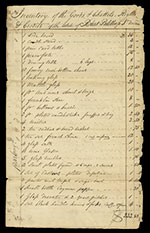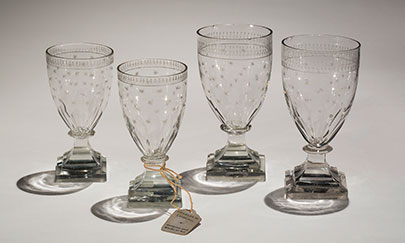| |
Ireland’s Glass Industry
In the 18th century, glassmakers in England and Ireland (which was part of Great Britain) created exquisite glassware known as Anglo-Irish glass. These English and Irish craftsmen had learned techniques for producing fine glass from the Venetian artisans who had dominated European high end glassmaking prior to this time.
Yet, these English and Irish artisans evolved a distinct recipe that differed in its composition from Venetian glass: a mixture containing calcinated flints and pebbles, and employing lead oxide as a flux, or binder. The lead gave their glass a higher degree of refraction, creating glass that, when cut, could exude a brilliance unseen in previous European wares, greatly increasing its reflective qualities. In the shadowy, candlelit rooms of the 18th century, this increased illumination was very welcome. Soon, these English and Irish glassmakers specialized in cut glass—clear glass, not colored, since it better showed the brilliance of the faceting. These English and Irish makers built factories during the first half of the 18th century as the unique refractive quality of their glass gained them worldwide fame.
As part of the British Empire, Ireland was subject to British trade policies. Indeed, from 1745 until 1780, the Irish glass industry was not allowed to compete with English-made glass within the British Empire. Irish entrepreneurs put pressure on the British Parliament and in 1780 all restrictions were lifted. This “Period of Freedom,” as it was known, continued until 1825, when Parliament reinstated the tariffs. During this relatively brief span, the Irish glass houses of Dublin, Belfast, Cork, and Waterford produced incomparable wares, based on contemporary English designs. During this period of free trade, Irish glassmakers exported a large amount of glassware of all kinds—everything from tiny salt cellars and wine glasses to large scale candelabras and chandeliers.
Irish Glass in American Homes
Beginning in the 1780s, Americans saw significant Irish imports, although these would have been sold alongside glass from Central Europe (Germany and Bohemia) as well as British goods made in England. Nevertheless, the reputation for finely cut and faceted chandeliers and tableware put Irish glass at a premium. Americans loved the look of Irish glass. The dazzling effect of the reflection in candlelight showed that Americans, now independent of Britain, could attain interiors as fashionable as those in London.
In addition to dining rooms where cut glass serving ware predominated, Irish cut glass might be placed in parlors and other public rooms. If the homeowner was very wealthy, a candlelit chandelier could find its way into a parlor, too.

Click above image to enlarge |
|
A preference for glass tableware extended well below the upper crust in late 18th-and early 19th-century America. The estate inventory of Robert Palethorp, Jr., a 27-year-old Philadelphia pewterer who died in 1822, reveals much about the contents of his middle class household.
The goods in the parlor of Palethorp’s five-room house included 4 glass salts, 11 wine glasses, 5 glass tumblers, 1 glass decanter and 2 quart pitchers (that were also probably made of glass).THF113594 |
|
|
American Glassmakers Join In
In the years following American independence, there was an interest in building a local glass industry. In the first half of the 19th century, foreign craftsmen, including Irish emigrants, sought greater opportunities in America. By the 1830s and 1840s, various firms—established by American entrepreneurs as well as immigrant craftsmen—located in coastal cities like Baltimore and Philadelphia, and inland places such as Pittsburgh and Wheeling, West Virginia. They gained renown for their fine cut glass tableware, many based on Anglo-Irish designs.
During the late 1820s and 1830s, American entrepreneurs also began experimenting with machine-pressed glass as a less costly alternative to cut glass. One of the leaders in this field was the Boston and Sandwich Glass Company, based in Sandwich, Massachusetts. Their early works are known as “Lacy” glass, which have a stippled surface intended to hide wrinkles caused by machine pressing on cold glass. Early pressed glass manufacturers sought to imitate the motifs found in expensive cut glass, specifically those pieces made in English and Irish glass houses. Americans of all economic means soon adopted pressed glass, although for the very wealthy, demand continued for cut glass.
Irish glass as a force in the international marketplace declined precipitously in the years after 1825. The impact of inexpensive pressed glass combined with a reinstatement of tariffs quickly decimated Ireland’s glass industry. The last to close was the Waterford house in 1851. (The firm that we know today was reestablished in 1947.)
The legacy of Irish glass lies in the elegant tableware and chandeliers of deeply cut, prismatic glass that we treasure today.
| |
-- Charles Sable, Curator of Decorative Arts |
Henry Ford and Anglo-Irish Glass
 Click above image to enlarge Click above image to enlarge
Nearly all of the Irish glass in The Henry Ford’s collection was acquired in the 1920s and 1930s, when Henry Ford began collecting in earnest for his museum. The objects included elegant chandeliers to light the front corridors of the museum (after being electrified), and cut-glass lighting devices and tableware to display in exhibits. For much of his early collecting activities, Henry Ford employed antiquarians such as Charles Woolsey Lyon, who helped locate and acquire decorative arts objects. In addition to Henry Ford, Lyon also acquired works for the Metropolitan Museum of Art, the Boston Museum of Fine Arts, and Henry Francis du Pont, who went on to found Winterthur Museum in Delaware. THF155631
|
|
|

